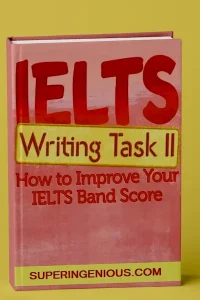IELTS Writing Academic Task 2 book is a detailed guide for IELTS candidates on how they can improve their IELTS Writing Task 2 Test band score.
The second question in the IELTS Academic Writing Test asks you to write an essay of at least 250 words. The question may ask you to agree or disagree on a particular idea or opinion; sometimes, the question may directly ask your stand on a particular issue.
It may also ask you to cite some advantages and disadvantages of a particular idea, action, or event. The amount of time given to accomplish this task is 40 minutes.
A key technique for this task is to ensure you do not take longer than 40 minutes. This is because students would usually score higher marks in the first part of the next section of the IELTS Test than they would score by spending extra time on this task. DO remember though, that Task 2 is worth 66 or 2/3 of your marks, so twice as much.
How This Book Helps You
This book gives you, the IELTS Test candidate, detailed guidance on how you can improve your IELTS Writing Academic Task 2 Test band score.
The IELTS Writing Task 2 Test is no different from any other exam or test type. There are techniques, which can be practiced and which will place candidates in a better position to answer each given question type.
This book teaches you those techniques for the IELTS Writing Task 2 Test.
Both Task 1 and Task 2 are rated based on four criteria: Task Achievement(Task 1) and Task Response (Task 2), Coherence and Cohesion, Lexical Resource, and Grammatical Range and Accuracy.
Scores range from 0 to 9, and a 0.5 rate may also be given. To better understand each criterion, carefully study the descriptors below.
9 Techniques for Better IELTS Writing Task 2 Band Score
The techniques are listed below, and each relates to a chapter in this book that teaches IELTS Test candidates the required skills.
- Technique 1: Reading and analyzing the question.
- Technique 2: Essay format – planning and outlining.
- Technique 3: Brainstorming for good ideas and opinions.
- Technique 4: The introductory paragraph – thesis statement.
- Technique 5: The body – topic sentence; main idea and support ideas.
- Technique 6: Time management.
- Technique 7: Linking devices and expressions.
- Technique 8: The conclusion – restatement or summary.
- Technique 9: Common mistakes – syntax and Alexis.


